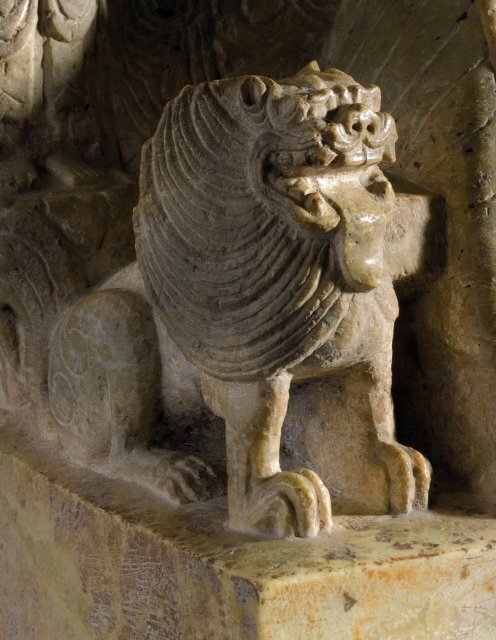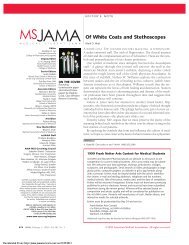SPECIALISTS AND SERVICES FOR THIS AUCTION
NYR14319_SaleCat
NYR14319_SaleCat
Create successful ePaper yourself
Turn your PDF publications into a flip-book with our unique Google optimized e-Paper software.
Most traditional Chinese wooden and stone sculptures, including steles, originally were painted,<br />
the faces and other fesh portions sometimes further embellished with gold leaf, to make them as<br />
naturalistic and as radiant as possible. Few such sculptures retain their pigments today, but many<br />
bear traces of the rich colors, as do these three rare steles from the Fujita Museum.<br />
Dated to 526—the second year of the Xiaochang reign—the exquisite Northern Wei stele from the<br />
Fujita Museum represents a Chinese adaptation and interpretation of the Indian stele style type,<br />
particularly the type carved in Sarnath ( 鹿 野 苑 ), in Uttar Pradesh ( 北 方 邦 ), in the late ffth century,<br />
during the Gupta dynasty ( 古 普 塔 時 代 ; c. AD 320 – 550). In such Gupta steles, the fgures—often just<br />
a single Buddha—appear on a plinth and rise in high relief against a vertical mandorla with rounded<br />
top and beaded border 3 . In the Chinese transformation of the type, the stele becomes formalized to<br />
include multiple fgures hierarchically arranged in a symmetrical grouping; in addition, the mandorla<br />
not only assumes a lotus-petal shaped with a small point at the top but is highly embellished, and<br />
the plinth typically features a dedicatory inscription, often including the date along with the names of<br />
monks and donors.<br />
The 526 stele is the simplest of the three Fujita steles in terms of iconography, featuring a seated<br />
Buddha—likely the Historical Buddha Shakyamuni ( 釋 迦 牟 尼 佛 )—at the center fanked on either side<br />
by a standing bodhisattva (pusa 菩 薩 ). A lion crouches at the foot of each bodhisattva. The fgures<br />
appear on an inscribed, table-like plinth, and an intricately embellished, lotus-petal-form mandorla<br />
rises behind the triad of deities. The peaceful fgures embody a profound spirituality. The Buddha<br />
raises his right hand in the abhaya-mudra ( 施 無 畏 印 ), or gesture of “do not fear”, and lowers his left<br />
THE BODHISATTVAS CLASP THEIR H<strong>AND</strong>S<br />
BE<strong>FOR</strong>E THEIR CHESTS, PALMS TOUCHING, IN<br />
THE ANJALI-MUDRA ( 合 掌 印 OR 合 十 印 ), A GESTURE<br />
INDICATING VENERATION.<br />
in the varada-mudra ( 予 愿 印 or 予 願 印 ), or gift-giving gesture, the two mudra together indicating that<br />
he is preaching. (A ritual hand gesture, a mudra—shouyin ( 手 印 ) or yinxiang ( 印 相 )—symbolizes a<br />
particular action, attitude, or power of a deity.) The bodhisattvas clasp their hands before their chests,<br />
palms touching, in the anjali-mudra ( 合 掌 印 or 合 十 印 ), a gesture indicating veneration.<br />
Of course, a Buddha appears as the central and most important fgure in each of the three steles. The<br />
term “Buddha” (fo 佛 ) means “the Enlightened One”. 4 The Buddha is an individual who has attained<br />
enlightenment and has entered into nirvana, or niepan ( 涅 槃 ). Presented in the guise of a monk, the<br />
Buddha generally is depicted with a single head, two arms, and two legs; he may be shown standing<br />
or seated and always displays a benevolent countenance. He wears a monk’s robes and may be<br />
shown either barefoot or with sandals. Buddhas typically are portrayed without jewelry. His elongated<br />
earlobes, which resulted from the heavy earrings that he wore in his youth as a crown prince,<br />
symbolize his rejection of worldly life and his embrace of the religious life. He may be represented<br />
with a shaven pate or with short hair arranged either in small, snail-shell curls or, as in the 526 stele,<br />
in wavy locks. The sutras state that he bears the “32 Marks of a Great Man”; among those marks, the<br />
ones typically portrayed are the urna (baihao 白 毫 ), or circular mark at the center of the forehead, the<br />
webbed fngers and toes, and the ushnisha, or foding ( 佛 頂 ), which is the cranial protuberance atop the<br />
head that symbolizes the expanded wisdom that he gained at his enlightenment. In fact, the ushnisha<br />
is the Buddha’s diagnostic iconographic feature, as no other being bears that iconographic attribute.<br />
3 For examples of sculptures of the Buddha carved at Sarnath in the late ffth century, see a Standing Buddha from the Mr.<br />
and Mrs. John D. Rockefeller Collection at The Asia Society Museum, New York (1979.5) or the related one in the collection of<br />
the British Museum, London (Asia 1880.15).<br />
4<br />
For books on Buddhist art, see: Pratapaditya Pal et al., Light of Asia: Buddha Sakyamuni in Asian Art, Los Angeles: Los<br />
Angeles County Museum of Art, 1984; Denise Patry Leidy, Donna Strahan, et al., Wisdom Embodied: Chinese Buddhist and<br />
Daoist Sculpture in the Metropolitan Museum of Art, New York: Metropolitan Museum of Art and New Haven: Yale University<br />
Press, 2010; Marsha Weidner, ed., Latter Days of the Law: Images of Chinese Buddhism, 850-1850, Lawrence, KS: Spencer<br />
Museum of Art, University of Kansas, and Honolulu: University of Hawaii Press, 1994; Pratapaditya Pal, The Arts of Nepal,<br />
Leiden, The Netherlands: E. J. Brill, 1974; Pratapaditya Pal, ed., On the Path to Void: Buddhist Art of the Tibetan Realm, Mumbai:<br />
Marg Publications, 1996.<br />
240 IMPORTANT CHINESE ART FROM THE FUJITA MUSEUM



